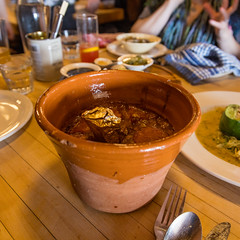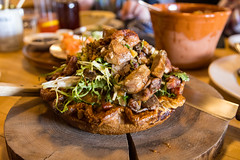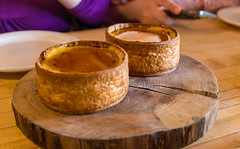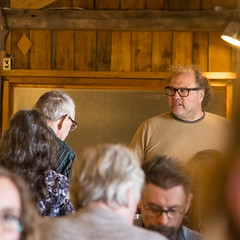As our regular readers know, one of the periodic traditions here at Offbeat Eats is to pile in the car, drive up to Montreal, rendezvous with friends, and head out to the quiet town of St. Benoît de Mirabel west of Montreal to the Cabane à Sucre of famed Montreal restaurant Au Pied de Cochon. You can read up on previous visits of ours in 2014 and 2017, or their similar harvest dinner in Fall 2019, but it’s basically always a sumptuous feast featuring maple (Winter), or Fall harvest (Fall) ingredients, served up in an unending serious of generously-portioned courses, usually with a total of between 9 and 14 courses (often with a variety of supplements available as well). It’s one of the Montreal-area’s more difficult reservations to get, and the whole Pandemic thing caused this event to get canceled twice, and then we were too busy with other travels to attend. But this year, everything aligned with availability, and our friend Elizabeth took the lead in securing reservations, scoring a noon-time seating in late April.
The drive out to Mirabel from Montreal is fairly easy and straightforward, taking only about an hour even with the fairly heavy weekend Montreal traffic. As far as the Cabane itself, the overall experience and ambiance have changed little from 2019 (although the winter sessions are a lot more sparsely decorated outside, due to the retreat of winter snows; in the fall, the outside of the Cabane is actually a nicely-appointed patio space). Note to other diners: if you get a later booking, they are often serving wine and appetizers on the patio as they wait for the noon seating to finish up, so remember that when choosing times (although the early booking definitely allows more recovery time later in the day!).
Inside, it’s pretty much the same dining experience as previous years, with most of the interior of the Cabane set up as a cozy dining room with long tables for serving between 10 and 16 diners, depending on the particular table, Seating continues to evolve; when we started doing these half the seating was square eight-toppers, now everything is bar seating or the long benches. The benches, however, got padded a few years back, making for a more comfortable dining experience, and they’ve removed the wood stove at one end of the dining room in favor of more seating.
Despite the fairly informal seating arrangments, the hospitality at the Cabane à Sucre is top notch; moments after getting seated our bilingual hosts were describing their drink menu for us and taking cocktail orders. While we waited for the first of many courses to arrive from the kitchen, I enjoyed my cocktail, La Ginette, a very herbal cocktail of the house brand gin (Gin Matante), Luxardo, Basilic (an herbal basil liqueur), Chartreuse, lime jelly, and maple syrup, with a splash of ginger beer. I’ll have to play around with this a bit and see if I can make up something similar with my own bar.
The actual courses started arriving shortly thereafter. The first up was a variation on the classic French Paris Brest. This was a ring of nice, delicate choux pastry, topped with parfait foie gras, chicken liver mousse, maple butter, blackcurrent gel, hazelnut mousseline, and gold leaf. The combination of foie gras and chicken liver mousse with the sweet notes of the maple butter and hazelnut mouuseline was an interesting choice, since it gave a savory and sweet note at the same time, but this worked quite well for me, with the crisp of the choux pastry tying everything together nicely. This is a good place to mention the Cabane’s service: while the menu is fixed and there are various prohibitions against substitutions (I can almost imagine the horror of the staff if asked to serve up something vegan, since everything in this meal seemed to have at least foie gras and bacon in it), they were actually quite accommodating with a request for gluten-free dishes. In this case, our gluten-free diner got the same filling as the rest of us, but had it served up in a small parfait instead of filled in the pastry. Similar accommodations were provided for most of the other courses as well.
Next up was a Québécois classic: yellow pea soup, with pan fried mushrooms, bacon and foie gras. Served up as an entire Le Crueset cast iron enamelware soup pot filled almost to the brim (for a table of eight, so we had almost 2 quarts extra that left in our takeout containers), the soup itself was the classic pea soup that I always find satisfying, with just the right amounts of pork broth, pea flavor, and smokiness, and was elevated by the nice pan-fried mushrooms, generous bacon garnish, and bits of foie gras dispersed in the soup. Honestly, if I had just a hearty bowl of this soup and a slice of bread, I’d call that a good meal in itself.
The third course was stuffed duck, with white sausage, maple and sour cherries sauce and parsnip purée. Another surprise here, this was a perfectly textured roulade, and the white sausage filling was a lightly-herbed variety so it didn’t overwhelm the subtler tastes of the duck. Both the maple and cherries added some nice sweet and sour notes to this, almost like a cranberry sauce would. Nicely composed, this was another popular dish at the table.
Course four arrived at the same time as the duck and the soup, and everyone’s first thought was that they had just dropped off a large bowl of pork rinds as topping for the soup (which wouldn’t have been a bad idea!). But this actually was a salad course; underneath the bountiful layer of perfectly crisp pork rinds was an endive salad with gin-pickled cucumbers, anchovy vinaigrette, and cheddar cheese. Yes, there was a salad under there. This was actually quite a popular dish; one star was the pickles, with just the right amount of sweet pickle flavor from the gin. Combined with a bit of cheddar, a bit of pork rind, a bit of endive, and the dressing, each bite had both a pleasant texture and a nice combination of flavors. This was actually one of my favorites, even if the level of anchovies was high enough to start triggering my fish sensitivity. Oh well, you only live once.
The fifth course was an egg soufflé, served au gratin over potato and leeks, with creton (that cloved-spiced Québécois potted pork product), and a gin and cheese sauce. This was one of the favorites of the table: the soufflé itself being a masterfully-executed light and fluffy cloud sitting over a potato/leek mixture that added the perfect amount of texture and flavor. A few times in the last few months I’ve had perfectly prepared potatoes, and these were a good example: a soft just barely al-dente texture without actually falling apart, soaking up the rich cheese sauce and leek flavors, the potatoes themselves were one of the stars here.
After a short intermission (where several of us took a few minutes to walk around outside and get some fresh air), the remaining main courses started to arrive. The sixth course was a Martin Picard specialty, the the “Cassoulard”. A variation of cassoulet (his “Canarde en Conserve” served up at the main PdC restaurant is a duck-forward one) with more beans to make it a bit more like baked beans, this was essentially just a really flavorful and rich cassoulet; tender beans, bits of duck and sausage, and a rich sauce. This was also a particularly popular dish for taking the extras home with us.
The seventh course was a maple-glazed duck, served with crêpes and Asian garnishes. I’d basically describe this course as a fusion between Québécois cuisine and classic Peking duck, just with the duck primarily glazed with maple. This was a whole duck (including the neck and head, cut lenghtwise in half), with the breast itself nicely removed from the duck, sliced, and served up. This was also recommended to be eating like Peking Duck, with the dinner taking a French crêpe, placing some duck breast on it, topping it with sliced braised diakon, green onions, and some provided sauces, rolled up, and eaten. This was also a hit, and while waiting for the next courses to arrive we picked over the other bits of the duck with the provided chopsticks to extract all sorts of other tasty morsels.
Cod with Fish Mousse, the one dish I didn’t actually try (I had already pushed my seafood intolerance back on Course 4 with the Endive salad, which had a lot of anchovy in it), but this was generally quite well-received by the group as well.
The next course wasn’t one of the regular courses, but the supplemental meat pie. Like back in 2017, this an optional $100cdn add-on to the meal ordered at the beginning. It’s become a bit of a joke, since with our particular group of diners, it is almost inconceivable that we wouldn’t order the meat pie, despite the extreme excess of the meal already consumed by the time the meat pie shows up. Because, like the previous pie in 2014, this is basically the mother of all meat pies. A solid 12 inch pie, over 3 nches deep, with a thick, fluted flaked crust. The interior was basically a mix of bacon, pork and various bits of offal, an entire half-inch thick slice of brie. Add some more pastry, and then top that with a maple-dressed endive salad and fried sweetbreads. This was pretty much the same dish as 2017, with almost five lbs of food all in one “pie”; even with a generous wedge served up to everyone, we still have half of the pie remaining to get portioned into our takeout containers. And this was a particularly tasty pie: tasty offal morsels soaked with Brie and a nice pastry crust.
As we enjoyed the meat pie, we hit the home stretch with the dessert courses starting to arrive (again, if there is any single phrase that you should invoke at the Cabane, it is “Mais attendez, il y a plus!” (“But wait, there’s more!”)). First to arrive was a pair of maple caramel flans, served up wrapped in a pastry crust with fresh maple syrup poured atop. These were quite picturesque desserts, enough so that we opted to simply take one of the flans home while portioning the other into small wedges for consumption. But this was essentially a maple variation of a classic flan, with a good firm texture that wasn’t at all chalky, and more than just containing the flan, the surrounding pastry was flaky, tender, and actually added to the dish. I’m looking forward to finishing the take-home portion as I’m writing this.
The second dessert course was a maple-condensed milk mousse served with jellied cider, strawberry purée, and a cookie base. This was a particularly sweet dish, but quite flavorful. With a resulting texture some place between “flan” and “crême caramel”, this was a nice basic mouse, and the bits of strawberry purée, and the cookie based added a bit of nice crunch. An overall good dessert, but this was definitely the weakest of the dessert courses.
The grand finale (for those counting along, this was the twelfth course!) was a the maple baked Alaska Bombe (Americans know this as “Baked Alaska” with caramelized hazelnuts, served with flambéed brandy poured over it. While also quite the sugar bomb at the end of a meal that already has a legendary amount of excess, I actually really enjoyed this course. The maple ice cream was particularly richly-maple flavored, the hazelnuts adding a nice nutty note, and the meringue perfectly crisped. We all ended up focusing on this one for dessert since this one wasn’t go to travel as leftovers, but for me it was a classic in presentation and delivery.
Also, one of the things I enjoyed about this particular Cabane à Sucre was that Chef Martin Picard was actually out front in the dining room, visiting each table, discussing the food, and generally being a welcome host. He’s done more than most any other chef in expanding the reputation of Québécois cuisine, and it’s obvious from seeing his interaction with both our table and others that this really is a passion of his. And it’s really enjoyable seeing all of the other tables enjoying their giant family-style maple feasts.
As always, a trip to the Cabane à Sucre was thoroughly enjoyable and delicious… and truly excessive. As they clear the last course from the table, we end up gazing upon “le carnage” of all the empty plates and consider whether walking back to Montreal isn’t the most terrible idea. I definitely need to try a few of the other experiences that Au Pied de Cochon offers up, including summertime picnics in their orchards, but the maple dinner remains a classic, even with the newly-updated prices. It remains one of the region’s best culinary shock-and-awe campaigns, and this his dinner was only 94cdn per person, around $67 American with the exchange rate at the time, plus supplements for the special meat pie and our cocktails. Even with the supplements, it still ends up being a truly great deal, especially for the number of courses and the unique preparations, and most everyone ends up leaving with multiple meals’ worth of food in various takeout containers.
However, I do realize every year on the drive to Au Pied de Cochon Cabane à Sucre that I’m passing a good number of other Cabane à Sucres, and that one of these years I should try one of the more traditional offerings just to see what they are like. Do any of my readers have recommendations?
Otherwise, this remains a classic of Québécois dining, and an experience that I think every adventuresome eater in New England and Quebec should try to experience at some point.




















Such great fun!